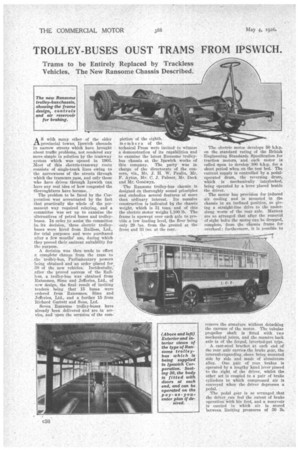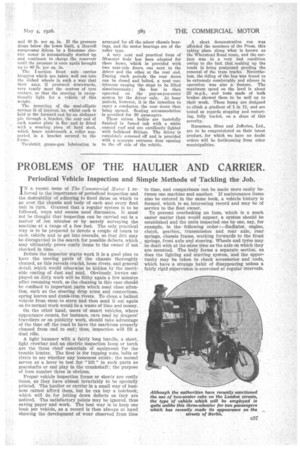TROLLEY-BUSES OUST TRAMS FROM IPSWICH.
Page 20

Page 21

If you've noticed an error in this article please click here to report it so we can fix it.
Trams to be Entirely Replaced by Trackless Vehicles, The New Ransome Chassis Described.
AS with many other of the older provincial towns, Ipswich abounds in narrow streets which have brought about traffic problems, not rendered any more simple in solution by the tramway system which was opened in 1903. Most of this electric-tramway route consists of single-track lines owing to the narrowness of the streets through which the tramcars pass, and only those who have driven through Ipswich can have any real idea of how congested the thoroughfares have become.
The problem to be faced by the Corporation was accentuated by the fact that practically the whole of the permanent way required relaying, and a committee was set up to examine the alternatives of petrol buses and trolley. buses. In order to assist the committee inits decision, three electric trolleybuses were hired from Railless, Ltd., for trial purposes and were purchased after a few months' use, during which they proved their eminent suitability for the purpose.
A decision was then -made to effect a complete change from the tram to the trolley-bus, Parliamentary powers being obtained and an order placed for 30 of the new vehicles. Incidentally, after the proved success of the Railless, a trolley-bus was obtained from Ransomes, Sims and Jefferies, Ltd., of new design, the final result of inviting tenders being that 15 buses were ordered from Ransomes, Sims and Jefferies, Ltd., and a further 15 from Richard Garrett and Sons, Ltd.
Seven Ransome trolley-buses have already been delivered and are in service, and upon the occasion of the corn
pletion of the eighth, members of the technical Press were invited to witness a demonstration of its capabilities and to examine the latest Ransome trolleybus chassis at the Ipswich works of this company. The party was in charge of the directorate of the concern, viz., Mr. J. U. W. Paulin, Mr. F. Ayton, Mr. C. J. Palmer, Mr. Deck and Mr. Goodwyn.
The Ransome trolley-bus chassis is designed on thoroughly sound principles and embodies several features of more than ordinary interest. Its massive construction is indicated by the chassis weight, which is 31 tons, and of this the electric motor weighs 1,100 lb. The frame is upswept over each axle to provide a low loading level, the floor being only 29 ins, from the ground at the' front and 33 ins, at the rear.
The electric motor develops 50 b.k.p. on the standard rating of the British Engineering Standards Specification for traction motors, and each motor is called upon to develop 100 b.h.p. for a short period when on the test bed. The current supply is controlled by a pedaloperated drum, the reversing drum, which is mechanically interlocked, being operated by a lever placed beside the driver.
The motor has provision for induced air cooling and is mounted in the chassis in an inclined position, so giving a straight-line drive to the underslung worm of the rear axle. Matters are so arranged that after the removal of eight bolts the motor can be dropped, complete, from the chassis frame for overhaul ; furthermore, it is possible to remove the armature without detaching the carcase of the motor. The tubular propeller shaft is fitted with two mechanical joints, and the massive back axle is of the forged, inverted-pot type. A cast-steel bracket at each end of the rear axle carries,the brake gear, the internal-expanding shoes being mounted side by side and made of aluminium alloy. One pair of rear brakes is operated by a lengthy hand lever placed to the right of the driver, whilst the other set is coupled to a pair of brake cylinders to which compressed air is conveyed when the driver depresses a pedal.
The pedal gear is so arranged that the driver an feel the extent of brake operation with his foot, and a reservoir is carried in which air is stored between limiting pressures of 20 lb. and 40 lb. per sq. in. If the pressure drops below the lower Unlit. a Reeve11 compressor driven by a Rensome electric motor is automatically started up end continues to charge the reservoir until the pressure is once again brought up to 40 lb. Per sq. in.
The I-section front axle carries kingpins which are taken, well out into the dished wheels in such a way that their axes, if produced downwards, very nearly meet the centres of tyre contact, so that the steering is exceptionally light for a 'vehicle of this weight.
The mounting of the semi-elliptic springs Is of interest, as, whilst each is held at the fotward end -by an ordinary' pill through a bracket, the rear end of each muter plate is flat' and is fitted with a wearing piece of hard steel, which bears underneath a,. roller supported In a bracket secured to the frame.
Tecalemit grease-gun lubrication is arranged for all the minor chassis bearings, and the motor hearings are of the roller type.
A very neat and practical form of 30-seater body has been adopted for these buses, which is 'provided with two near-side doors, one next to the driver and the other at the rear end. During slack periods the rear doors can be closed and bolted, a neat con-, trivauce causing the steps to be lifted simultaneously ; the bus is then operated on the pay-as-you-enter system by the driver only. At busy periods, however, it is the intention to carry a conductor, the rear doors then being opened. Seating accommodation is.provided for 30 passengers.
These saloon bodies are tastefully finished in fumed oak with a white enamel roof and are excellently lighted with bulkhead fittings. The driver is completely screened off and is provided with a separate entrance door opening to the off side of the yebide.
A short demonstration run was afforded the• members of the Press, this taking place along what is known as the Wherstead Road route, and the surface was in a very bad condition owing to the fact that making up the roads is being postponed pending the removal of the tram tracks. Nevertheless, the riding of the bus was found to be extremely comfortable and silence in operation was also a feature. The maximum speed on the level is about 22 m.p.h., and tests made of both brakes showed them to be well up to their work. These buses are designed to climb a gradient of I in 11, and are tested as regards stopping and restarting, fully loaded, on a slope of this severity.
Ransonies, Sims and je&des, Ltd, are to be congratulated on their latest product, for which we have no doubt orders will be forthcoming from other municipalities.
































